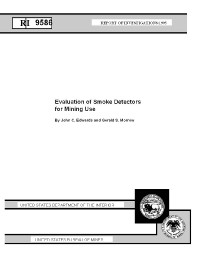 |
The U.S. Bureau of Mines has constructed a smoke chamber and developed sensitivity tests for smoke detectors. Response of ionization- and optical-type commercially available smoke detectors have been investigated. Six smoke detectors were measured with respect to visually obscuring smoke characterized by a corresponding optical density for smoldering and flaming coal combustion in the smoke chamber. It was determined that for one type of ionization smoke detector the alarm time was nearly equivalent to that of an odor monitor's alarm for smoldering coal combustion experiments and earlier for flaming coal combustion experiments. The experiments showed that an average carbon monoxide concentration of 5 ppm corresponded to an optical density of 0.022 m for smoldering and flaming coal combustion. Two of the commercially available ionization-type smoke detectors were more responsive to flaming than smoldering coal combustion at an optical density of 0.022 m , whereas the optical smoke detectors showed the opposite trend. The responsive characteristics of the detectors evaluated with respect to known smoke conditions in the smoke chamber shows their potential for use as mine fire sensors or part of a mine atmospheric monitoring system to improve mine safety.
| Author(s): | Edwards-JC, Morrow-GS |
| Reference: | Pittsburgh, PA: U.S. Department of the Interior, Bureau of Mines, Report of Investigations 9586. NTIS stock number: PB96-128566, 1995 |
ri9586 (PDF, 235 KB)